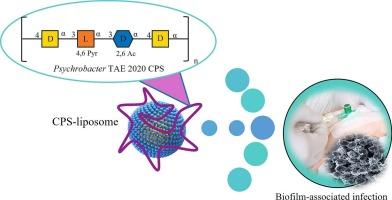Capsular polysaccharide from Psychrobacter sp. TAE2020: An unusual amino sugar-enriched macromolecule with anti-biofilm and emulsification activities
IF 12.5
1区 化学
Q1 CHEMISTRY, APPLIED
引用次数: 0
Abstract
Extracellular polysaccharides exhibit a broad range of biological activities, among which antibiofilm activity is of particular interest due to the growing clinical importance of biofilm-related infections. Psychrobacter sp. TAE2020, a marine Gram-negative bacterium, produces a molecular complex named CATASAN, endowed with antibiofilm properties. The aim of this study is the identification and structural characterisation of the polysaccharidic component of the CATASAN complex. Moreover, the interest was in finding the structural features possibly responsible for the anti-biofilm and emulsifying activities. Here, it has been demonstrated that the polysaccharide within the CATASAN complex corresponds to the capsular polysaccharide produced by Psychrobacter sp. TAE2020. The detailed primary structure of this CPS is here reported, which is composed of a tetrasaccharide repeating unit containing two residues of α-D-galactosamine, one residue of α-D-2,4-diacetamido-2,4,6-trideoxy-α-glucopyranose, and the unusual α-L-gulosamine. The physical properties of the CPS, such as its ability to adhere to hydrophobic surfaces and exhibit emulsifying activity, suggest that this polymer is a promising candidate for alternative anti-infective applications in clinical settings.

来自Psychrobacter sp. TAE2020的荚膜多糖:一种罕见的富含氨基糖的大分子,具有抗生物膜和乳化活性
细胞外多糖表现出广泛的生物活性,其中抗生物膜活性是特别感兴趣的,因为生物膜相关感染的临床重要性日益增加。TAE2020是一种海洋革兰氏阴性菌,产生一种名为CATASAN的分子复合物,具有抗菌膜特性。本研究的目的是鉴定和结构特征的多糖组成的CATASAN配合物。此外,我们的兴趣是寻找可能负责抗生物膜和乳化活性的结构特征。在这里,已经证明了CATASAN复合物中的多糖对应于由Psychrobacter sp. TAE2020产生的荚膜多糖。本文详细报道了该CPS的初级结构,它由一个含有两个α- d -半乳糖胺残基的四糖重复单元、一个α- d -2,4-二乙酰氨基-2,4,6-三脱氧-α-葡萄糖氨基残基和一个罕见的α- l -葡萄糖胺残基组成。CPS的物理性质,如其粘附疏水表面的能力和乳化活性,表明该聚合物是临床环境中抗感染应用的有前途的候选物。
本文章由计算机程序翻译,如有差异,请以英文原文为准。
求助全文
约1分钟内获得全文
求助全文
来源期刊

Carbohydrate Polymers
化学-高分子科学
CiteScore
22.40
自引率
8.00%
发文量
1286
审稿时长
47 days
期刊介绍:
Carbohydrate Polymers stands as a prominent journal in the glycoscience field, dedicated to exploring and harnessing the potential of polysaccharides with applications spanning bioenergy, bioplastics, biomaterials, biorefining, chemistry, drug delivery, food, health, nanotechnology, packaging, paper, pharmaceuticals, medicine, oil recovery, textiles, tissue engineering, wood, and various aspects of glycoscience.
The journal emphasizes the central role of well-characterized carbohydrate polymers, highlighting their significance as the primary focus rather than a peripheral topic. Each paper must prominently feature at least one named carbohydrate polymer, evident in both citation and title, with a commitment to innovative research that advances scientific knowledge.
 求助内容:
求助内容: 应助结果提醒方式:
应助结果提醒方式:


